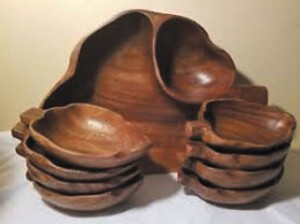One of my favorite parts of writing this column for the past 25 years are the e-mails I receive from you, the readers. Many times your questions involve defining a term that you are unfamiliar with and in answering your question I have also increased my “vintage vocabulary.” This week I am sharing with you some terms that are commonly used to describe vintage and antique items. See how many of them you know.
Monkey Pod — Monkey Pod is an a exotic hardwood and a favorite of woodworkers. In the world of vintage collectibles it is found in the form of salad bowl sets, groups of carved fruit, serving dishes in the shape of leaves and pineapples, furniture, as well as novelty souvenir items from the 1960s and 70s. Many of these items will be marked “made in the Philippines.”
Mid-Century Modern — You will often see this abbreviated to MCM. It refers to a style of furniture and home decor brought to this country after WWII by designers who migrated here from Germany. These highly collectible pieces were manufactured in the U.S. from the late 1940s to the late 1970s and are distinguished by their simple lines, bold colors and geometric designs. Designer names to watch for include Eames, Herman Miller and George Nelson. It should not be confused with the term “Mid-Century” which refers to a time period, not a design style.
Pannapictagraphist — This is the name for a person who collects comic books.
925 or 950 — You will often find the marks 925 or 950 on silver jewelry. It identifies the piece as being sterling silver and having a content of at least 925 or 950 parts silver for every 1,000 parts of the material. These numbers may sometimes be present by themselves or accompanied by the word “sterling.”
Bureau —There are actually two acceptable definitions here. You may remember your great grandmother using this word to describe the chest of drawers she kept in the bedroom. This is accepted as the “American” definition. Originally it was a term used in France and England to describe a desk with a slant top front and a set of 3-4 drawers on the bottom.
Marquetry — This term is often confused with the term parquetry, so let’s take a moment to define both. Marquetry is a style of inlay often found on antique furniture which uses different types of veneered wood to form a pictorial pattern. Parquetry is a similar process in wood crafting but the veneered wood is used to form a geometric pattern. There are those who will tell you that the two words are interchangeable. Now you know they aren’t!
Ephemera — The literal definition of ephemera is “things that exist or are used for a short time period”. When we apply this word in vintage terms it refers to paper goods such as pamphlets, cooking booklets, event tickets, posters and postcards. Ephemera is currently one of the fastest growing categories in collecting.
Original finish vs. Original condition — Original finish is just that. It is the finish the piece was given the day it was made. It is very important when purchasing fine antique furniture or primitives to be able to recognize original finish as it is one of the main factors used in determining value. Original condition refers to the over all condition of a piece. Does it have it’s original drawers and doors? Has the piece been stabilized by adding inappropriate wood? If anything has been removed or replaced, the value can be effected.
Knowing the terms that dealers use when assisting you with a purchase can help you avoid buyers remorse. Buyer’s remorse? That’s the sick feeling you get when you take your items home, inspect them more closely, and go OH NO?? And that is one term we all understand. Until next time . . . Linda
Linda Kennett is a professional liquidation consultant specializing in down-sizing for seniors and may be reached at 317-258-7835 or lkennett@indy.rr.com



